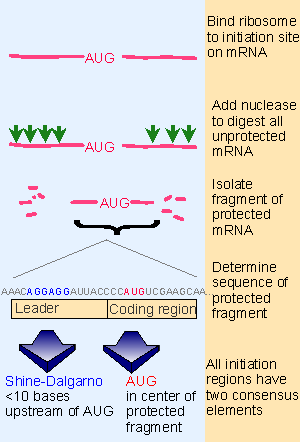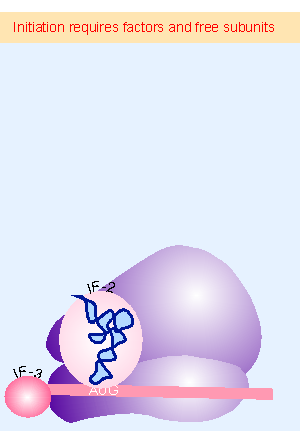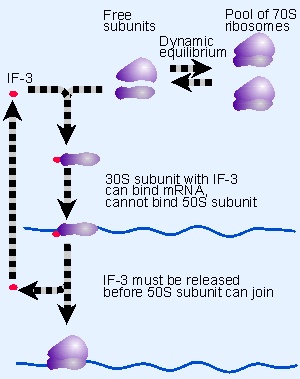3. Initiation in bacteria needs 30S subunits and accessory factors
6.3 Initiation in bacteria needs 30S subunits and accessory factors |
| Key terms defined in this section |
| Initiation factors (IF in prokaryotes, eIF in eukaryotes) are proteins that associate with the small subunit of the ribosome specifically at the stage of initiation of protein synthesis. |
Bacterial ribosomes engaged in elongating a polypeptide chain exist as 70S particles. At termination, they are released from the mRNA to enter a pool of free ribosomes. In growing bacteria, the majority of ribosomes are synthesizing proteins; the free pool is likely to contain ~20% of the ribosomes.
 |
Figure 6.8 Initiation requires free ribosome subunits. When ribosomes are released at termination, they dissociate to generate free subunits. Initiation factors are present only on dissociated 30S subunits. When subunits reaassociate to give a functional ribosome at initiation, they release the factors. |
Ribosomes in the free pool can dissociate into separate subunits; so free 70S ribosomes are in dynamic equilibrium with 30S and 50S subunits. Initiation of protein synthesis is not a function of intact ribosomes, but is undertaken by the separate subunits, which reassociate during the initiation reaction. Figure 6.8 summarizes the ribosomal subunit cycle during protein synthesis in bacteria.
 |
Figure 6.15 Ribosome-binding sites on mRNA can be recovered from initiation complexes. |
Initiation occurs at a special sequence on mRNA called the ribosome-binding site. This is a short sequence of bases that precedes the coding region (see Figure 6.15 later). The ribosome-binding site is a sequence at which the small and large subunits associate on mRNA to form an intact ribosome. The reaction occurs in two steps:
- Recognition of mRNA occurs when a small subunit binds to form an initiation complex at the ribosome-binding site.
- Then a large subunit joins the complex to generate a complete ribosome.
 |
Figure 6.9 Initiation factors stabilize free 30S subunits and bind initiator tRNA to the 30S-mRNA complex. Animated figure |
Although the 30S subunit is involved in initiation, it is not by itself competent to undertake the reactions of binding mRNA and tRNA. It requires additional proteins called initiation factors (IF). These factors are found only on 30S subunits, and they are released when the 30S subunits associate with 50S subunits to generate 70S ribosomes. This behavior distinguishes initiation factors from the structural proteins of the ribosome. The initiation factors are concerned solely with formation of the initiation complex, they are absent from 70S ribosomes, and they play no part in the stages of elongation (for review see 428). The animation of Figure 6.9 summarizes the stages of initiation.
Bacteria use three initiation factors, numbered IF-1, IF-2, and IF-3. They are needed for both mRNA and tRNA to enter the initiation complex:
- IF-3 is needed for 30S subunits to bind specifically to initiation sites in mRNA.
- IF-2 binds a special initiator tRNA and controls its entry into the ribosome.
- IF-1 binds to 30S subunits only as a part of the complete initiation complex, and could be involved in stabilizing it, rather than in recognizing any specific component.
 |
Figure 6.10 Initiation requires 30S subunits that carry IF-3. |
The role of IF-3 is illustrated in Figure 6.10. The factor has dual functions: it is needed first to stabilize (free) 30S subunits; and then it enables them to bind to mRNA. IF-3 essentially controls the freedom of 30S subunits, which lasts from their dissociation from the pool of ribosomes to their reassociation with a 50S subunit at initiation.
The first function of IF-3 controls the equilibrium between ribosomal states. IF-3 binds to free 30S subunits that are released from the pool of 70S ribosomes. The presence of IF-3 prevents the subunit from reassociating with a 50S subunit. In this capacity, it is an antiassociation factor that causes a 30S subunit to remain in the pool of free subunits. The reaction between IF-3 and the 30S subunit is stoichiometric: one molecule of IF-3 binds per subunit. There is a relatively small amount of IF-3, so its availability determines the number of free 30S subunits.
The second function of IF-3 controls the ability of 30S subunits to bind to mRNA. Small subunits must have IF-3 in order to form initiation complexes with mRNA.
IF-3 must be released from the 30S PmRNA complex in order to enable the 50S subunit to join. On its release, IF-3 immediately recycles by finding another 30S subunit.
| Reviews | |
| 428: | Maitra, U. et al. (1982). Initiation factors in protein biosynthesis. Ann. Rev. Biochem 51, 869-900. |